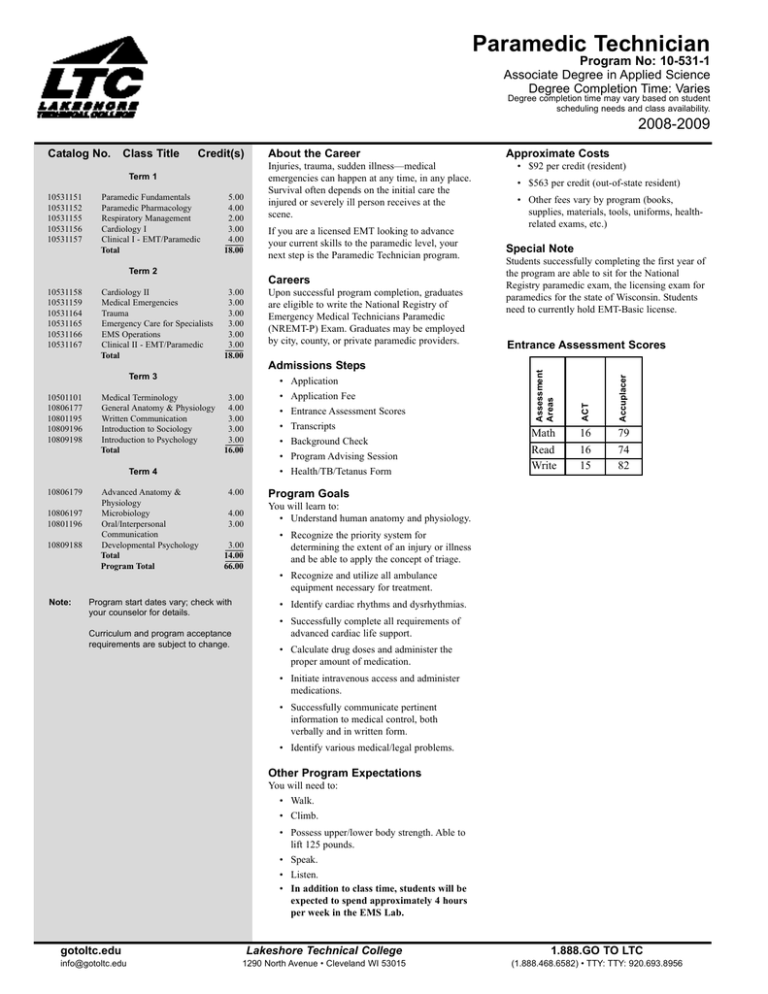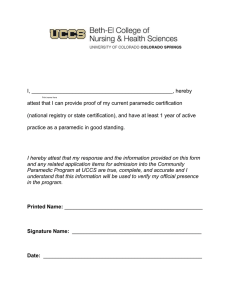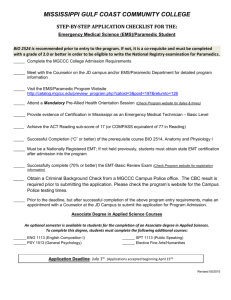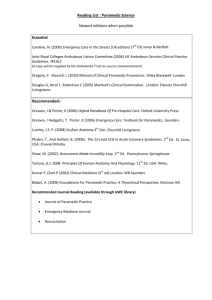Paramedic Technician 2008-2009 Program No: 10-531-1 Associate Degree in Applied Science
advertisement

Paramedic Technician Program No: 10-531-1 Associate Degree in Applied Science Degree Completion Time: Varies Degree completion time may vary based on student scheduling needs and class availability. 2008-2009 Term 1 10531151 10531152 10531155 10531156 10531157 Paramedic Fundamentals Paramedic Pharmacology Respiratory Management Cardiology I Clinical I - EMT/Paramedic Total 5.00 4.00 2.00 3.00 4.00 18.00 Term 2 10531158 10531159 10531164 10531165 10531166 10531167 Cardiology II Medical Emergencies Trauma Emergency Care for Specialists EMS Operations Clinical II - EMT/Paramedic Total About the Career Injuries, trauma, sudden illness—medical emergencies can happen at any time, in any place. Survival often depends on the initial care the injured or severely ill person receives at the scene. If you are a licensed EMT looking to advance your current skills to the paramedic level, your next step is the Paramedic Technician program. Careers 3.00 3.00 3.00 3.00 3.00 3.00 18.00 Upon successful program completion, graduates are eligible to write the National Registry of Emergency Medical Technicians Paramedic (NREMT-P) Exam. Graduates may be employed by city, county, or private paramedic providers. Admissions Steps Term 3 10501101 10806177 10801195 10809196 10809198 Medical Terminology General Anatomy & Physiology Written Communication Introduction to Sociology Introduction to Psychology Total 3.00 4.00 3.00 3.00 3.00 16.00 Term 4 10806179 10806197 10801196 10809188 Advanced Anatomy & Physiology Microbiology Oral/Interpersonal Communication Developmental Psychology Total Program Total 4.00 4.00 3.00 3.00 14.00 66.00 • • • • • • • Application Application Fee Entrance Assessment Scores Transcripts Background Check Program Advising Session Health/TB/Tetanus Form Approximate Costs • $92 per credit (resident) • $563 per credit (out-of-state resident) • Other fees vary by program (books, supplies, materials, tools, uniforms, healthrelated exams, etc.) Special Note Students successfully completing the first year of the program are able to sit for the National Registry paramedic exam, the licensing exam for paramedics for the state of Wisconsin. Students need to currently hold EMT-Basic license. Entrance Assessment Scores Accuplacer Credit(s) ACT Class Title Assessment Areas Catalog No. Math Read Write 16 16 15 79 74 82 Program Goals You will learn to: • Understand human anatomy and physiology. • Recognize the priority system for determining the extent of an injury or illness and be able to apply the concept of triage. • Recognize and utilize all ambulance equipment necessary for treatment. Note: Program start dates vary; check with your counselor for details. Curriculum and program acceptance requirements are subject to change. • Identify cardiac rhythms and dysrhythmias. • Successfully complete all requirements of advanced cardiac life support. • Calculate drug doses and administer the proper amount of medication. • Initiate intravenous access and administer medications. • Successfully communicate pertinent information to medical control, both verbally and in written form. • Identify various medical/legal problems. Other Program Expectations You will need to: • Walk. • Climb. • Possess upper/lower body strength. Able to lift 125 pounds. • Speak. • Listen. • In addition to class time, students will be expected to spend approximately 4 hours per week in the EMS Lab. gotoltc.edu Lakeshore Technical College 1.888.GO TO LTC info@gotoltc.edu 1290 North Avenue • Cleveland WI 53015 (1.888.468.6582) • TTY: TTY: 920.693.8956 Transfer agreements are available with the following institutions: Capella University Cardinal Stritch University Lakeland College Silver Lake College UW-Stout IMPORTANT: For more information on these agreements, visit gotoltc.edu/transfer. 10501101 Medical Terminology 10531159 Medical Emergencies 10806177 General Anatomy and Physiology ...prepares the learner to use appropriate medical terminology for the digestive, urinary, integumentary, reproductive, respiratory, endocrine, nervous, musculoskeletal, cardiovascular, and lymphatic systems and special senses. ...will provide the student with the knowledge and skills to integrate pathophysiological principles and assessment findings to formulate a field impression and implement a treatment plan for patients experiencing neurology, endocrine, allergic or an aphylactic emergencies, gastroenterology, renal/urology, toxicology, hematology, environmental emergencies, infectious and communicable diseases, and behavioral and psychiatric disorders. ...examines basic concepts of human anatomy and physiology as they relate to health sciences. Using a body systems approach, the course emphasizes the interrelationships between structure and function at the gross and microscopic levels of organizat ion of the entire human body. It is intended to prepare health care professionals who need to apply basic concepts of whole body anatomy and physiology to informed decisionmaking and professional communication with colleagues and patients. 10531151 Paramedic Fundamentals ...includes EMS systems, roles and responsibilities, wellbeing of the paramedic, illness and injury prevention, medical-legal aspects, ethics, general principles, pathophysiology, therapeutic communications, history taking, physical exam techniques, patient assessment, clinical decision making, verbal communication, and pathophysiology of shock. CONDITION: 105311 Paramedic Technician requirements met 10531152 Paramedic Pharmacology ...provides the opportunity for the student to develop the knowledge and understanding of basic pharmacodynamics, medication preparation, administration of medication and selected medications used in the treatment of disorders of the major body syste ms. In addition, it provides the student with the knowledge and skills to safely and precisely access the circulation and administer medications. COREQUISITE: 10531151 Paramedic Fundamentals and 105311 Paramedic Admissions requirements met 10531155 Respiratory Management ...provides the student with the knowledge and skills to establish and/or maintain a patent airway, oxygenate, and ventilate a patient. COREQUISITE: 10531152 Paramedic Pharmacology and CONDITION: 105311 Paramedic Technician requirements met 10531156 Cardiology I ...will provide the student with the basic knowledge and skills to integrate pathophysiological principles and assessment findings, with ECG interpretation, in order to formulate a field impression and implement the treatment for the patient with car diovascular disease. COREQUISITE: 10531155 Respiratory Management and CONDITION: 105311 Paramedic Technician requirements met 10531157 Clinical I - EMT/Paramedic 10531164 Trauma ...will provide the student with the knowledge and skills to integrate the principles of kinematics to enhance the patient assessment and predict the likelihood of injuries based on the patient's mechanism of injury. This course includes: soft tiss ue trauma, burns, head and facial trauma, spinal trauma, abdominal trauma, thoracic trauma, and mechanism of injury trauma systems. This course includes PHTLS Certification. COREQUISITE: 10531159 Medical Emergencies 10531165 Emergency Care for Specialists ...will provide the student with the knowledge and skills to formulate a field impression and implement a treatment management plan for the patient experiencing a gynecology, obstetrical, neonatal, pediatric, or geriatric emergency. This course also covers the victim of abuse or assault, patients with special challenges, acute interventions in the home care patient and life span development. 10531158 Cardiology II ...provides the student with the knowledge and skills to integrate a field impression and implement a treatment plan for a patient with Acute Coronary Syndromes (ACS) and includes Advanced Cardiac Life Support Certification. The student will gain an understanding of basic 12 lead ECG interpretation as it applies to the treatment for a patient with ACS. 10806179 Advanced Anatomy and Physiology ...is the second semester in a two-semester sequence in which normal human anatomy and physiology are studied using a body systems approach with emphasis on the interrelationships between form and function at the gross and microscopic levels of organ ization. Instructional delivery within a classroom and laboratory setting. Experimentation within a science lab will include analysis of cellular metabolism, the individual components of body systems such as the nervous, neuromuscular, cardiovascu lar, and urinary. Continued examination of homeostatic mechanisms and their relationship to fluid, electrolyte, acid-base balance and blood. Integration of genetics to human reproduction and development are also included in this course. PREREQUISIT E: 10806177 General Anatomy & Physiology 10806197 Microbiology 10531166 EMS Operations ...includes ambulance operations, medical incident command, rescue awareness, weapons of mass destruction, assessment based management, and NREMT-P prep. COREQUISITE: 10531165 Emergency Care for Specialists 10531167 Clinical II - EMT/Paramedic ...requires the student to complete 216 hours of documented practical skills application and observation at the beginning EMT - Paramedic level. The student will perform required skill competencies at a variety of clinical and field internship sites under the direct supervision of an approved preceptor. 10801195 Written Communication COREQUISITE: 10531151 Paramedic Fundamentals and CONDITION: 105311 Paramedic Technician requirements met PREREQUI SITE: 10806174 General Chemistry or 10806134 General Chemistry or High School Chemistry Equivalent COREQUISITE: 10531164 Trauma COREQUISITE: 10531158 Cardiology II ...is required to complete 288 hours of documented practical skills application and observation at the beginning EMT-Paramedic level. The student will perform required skill competencies at a variety of clinical and field internship sites under the direct supervision of an approved preceptor. PREREQUISITE: 10531156 Cardiology I COREQUISITES: 10531158 Cardiology II ...teaches the writing process, which includes prewriting, drafting, revising, and editing. Through a variety of writing assignments, the student will analyze audience and purpose, research and organize ideas, and format and design documents based o n subject matter and content. Keyboarding skills are required for this course. It also develops critical reading and thinking skills through the analysis of a variety of written documents. 10801196 Oral/Interpersonal Comm ...provides students with the skills to develop speaking, verbal and nonverbal communication, and listening skills through individual speeches, group activities, and other projects. ...introduces the learner to examine microbial structure, metabolism, genetics, growth and relationship between humans and microorganisms. Addresses disease production, epidemiology, host defense mechanisms and the medical impact of microbes. Exami nes the role of microbes in the environment, industry, and biotechnology. PREREQUISITE: 10806195 Anat and Phys I, or 10806177 General Anat and Physiology 10809188 Developmental Psychology ...introduces the student to the study of human development throughout the lifespan. This course explores developmental theory and research with an emphasis on the interactive nature of the biological, cognitive, and psychosocial changes that affect the individual from conception to death. Application activities and critical thinking skills will enable students to gain an increased knowledge and understanding of themselves and others. 10809196 Sociology - Intro ...introduces students to the basic concepts of sociology: culture, socialization, social stratification, multiculturalism, and the five institutions, including family, government, economics, religion, and education. Other topics include demograph y, deviance, technology, environment, social issues, social change, social organization, and workplace issues. 10809198 Intro to Psychology ...introduces students to a survey of the multiple aspects of human behavior. It involves a survey of the theoretical foundations of human functioning in such areas as learning, motivation, emotions, personality, deviance and pathology, physiologica l factors, and social influences. It directs the student to an insightful understanding of the complexities of human relationships in personal, social, and vocational settings. LTC is an equal opportunity/access employer and educator. Revised 12-1-07


